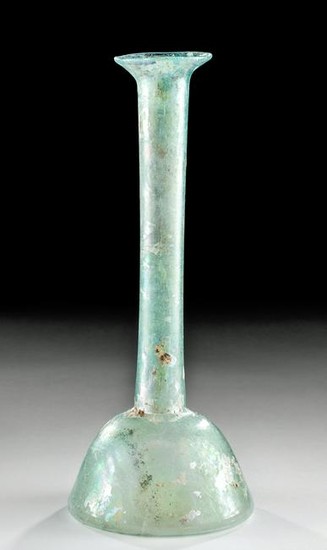Tall Roman Glass Candlestick Unguentarium
Roman, Imperial Period, ca. 1st to 3rd century CE. A translucent pale blue glass unguentarium with a bell-shaped body on a concave base, a form known as "candlestick", with a tall tubular neck that terminates in a flaring mouth and slightly rolled rim. The invention of glass blowing techniques occurred just as the Roman Empire was on the rise, making it possible for the glass industry to truly blossom among the ancient Romans. Size: 3.05" W x 7.3" H (7.7 cm x 18.5 cm)
Note Pliny's poetic homage to translucent hand-blown glass: "There is, furthermore, opaque white glass and others that reproduce the appearance of fluor-spar, blue sapphires or lapis lazuli, and, indeed, glass exists in any color . . . However, the most highly valued glass is colorless and transparent, as closely as possible resembling rock-crystal." (Pliny, Natural History XXXVI.198 from "Solid Liquid" catalogue, Fortuna Fine Arts, New York, 1999, p. 64.)
Provenance: private J.H. collection, Beaverton, Oregon, USA, acquired in August 2001; ex-Tom Cederlind collection, Portland, Oregon, USA
All items legal to buy/sell under U.S. Statute covering cultural patrimony Code 2600, CHAPTER 14, and are guaranteed to be as described or your money back.
A Certificate of Authenticity will accompany all winning bids.
We ship worldwide to most countries and handle all shipping in-house for your convenience.
#153282
Condition Report: Intact with light deposits and a lovely, delicate iridescent patina. Still nicely translucent in most places. The pontil mark is worn away, probably deliberately given how smooth the base is. A pontil scar or mark indicates that a vessel was free-blown, while the absence of such a mark suggests that the work was either mold-blown or that the mark was intentionally smoothed away or wore away over time.
View it on
Estimate
Time, Location
Auction House
Roman, Imperial Period, ca. 1st to 3rd century CE. A translucent pale blue glass unguentarium with a bell-shaped body on a concave base, a form known as "candlestick", with a tall tubular neck that terminates in a flaring mouth and slightly rolled rim. The invention of glass blowing techniques occurred just as the Roman Empire was on the rise, making it possible for the glass industry to truly blossom among the ancient Romans. Size: 3.05" W x 7.3" H (7.7 cm x 18.5 cm)
Note Pliny's poetic homage to translucent hand-blown glass: "There is, furthermore, opaque white glass and others that reproduce the appearance of fluor-spar, blue sapphires or lapis lazuli, and, indeed, glass exists in any color . . . However, the most highly valued glass is colorless and transparent, as closely as possible resembling rock-crystal." (Pliny, Natural History XXXVI.198 from "Solid Liquid" catalogue, Fortuna Fine Arts, New York, 1999, p. 64.)
Provenance: private J.H. collection, Beaverton, Oregon, USA, acquired in August 2001; ex-Tom Cederlind collection, Portland, Oregon, USA
All items legal to buy/sell under U.S. Statute covering cultural patrimony Code 2600, CHAPTER 14, and are guaranteed to be as described or your money back.
A Certificate of Authenticity will accompany all winning bids.
We ship worldwide to most countries and handle all shipping in-house for your convenience.
#153282
Condition Report: Intact with light deposits and a lovely, delicate iridescent patina. Still nicely translucent in most places. The pontil mark is worn away, probably deliberately given how smooth the base is. A pontil scar or mark indicates that a vessel was free-blown, while the absence of such a mark suggests that the work was either mold-blown or that the mark was intentionally smoothed away or wore away over time.



